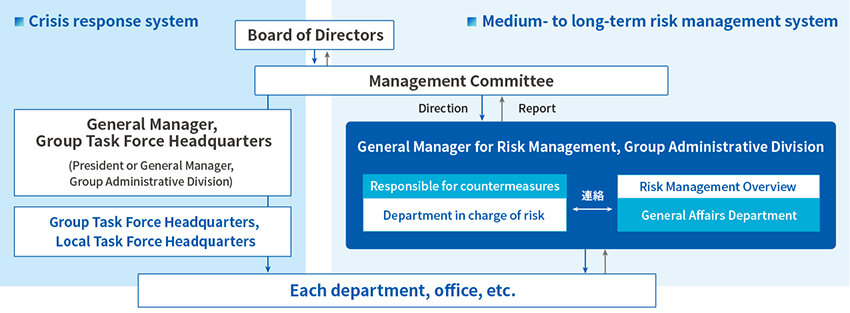Risk Management
| P | D | C | A |
| Targets for 2023 | Results in 2023 | Achievement | Targets for 2024 |
| Establishment and operation of a new risk management system | Continue to operate a risk management system that allows departments and workplaces to respond more autonomously and flexibly | ★★★ | Continuous improvement of risk management system |
| Continuation and enhancement of a crisis response drill jointly | Continuation and deepening of training through collaboration with overseas offices and introduction of new methods | ★★★ | Conduct crisis response drills to address new possible risks |
| Improvement of drills at each site including in preparation for earthquakes, accidents | Disaster prevention drills and safety confirmation drills, etc., conducted at each site | ★★★ | Improvement drills at each site including in preparation for earthquakes, accidents |
Concepts and Policies (Vision)
Based on the "Toagosei Group Risk Management Regulations," the Toagosei Group designates a department with jurisdiction over each risk and implements appropriate risk countermeasures, including the formulation of a business continuity plan (BCP) and risk management aimed at prevention and avoidance, led by the department with jurisdiction.
While each department evaluates risks and implements countermeasures, the Executive Committee and the Board of Directors periodically assess the overall risk profile of the Group and confirm the appropriateness of countermeasures, thereby ensuring prompt risk countermeasures and company-wide risk management.
In the event that a risk materializes, a Group task force is established to respond flexibly to the crisis situation.
Risk Management System

Risk Management and BCP
The Group has formulated a BCP to ensure business continuity in the event that risk materializes, and has established criteria for prioritized business continuity and a target recovery time based on damage conditions.
The Toagosei Group has established the Toagosei Group Crisis Response Rules that specify the organizational framework and concrete measures in the event of a crisis.
Moreover, the Emergency Action Manuals have been prepared according to respective phenomenon and office, and training is conducted regularly.
In addition, each risk is evaluated based on its probability of occurrence and impact, which is used for overall risk management and prioritization of countermeasures.
Crisis Situation Response Training
To ensure that we can take prompt and appropriate action in the event of a crisis situation, we conduct crisis response drills based on various scenarios.
We conduct drills using a variety of methods, including demonstrations and discussion-based diagrammatic drills, based on the nature of the situation and the status of our efforts.
Each department shares the issues identified during training and takes actions for improvement.
In 2023, for the first time, we conducted a crisis preparedness drill in cooperation with our overseas offices.
We were able to confirm that each country and region has different issues, such as means of obtaining and sharing information overseas, and we were also able to sort out issues specific to overseas operations, such as evacuation of expatriates and delegation of authority.
Currently, we are studying countermeasures based on these issues.
Risk Countermeasures for Information Security
Security measures are taken at the entrance, exit, and internal levels with multi-layered protection. Major measures include firewalls, anti-virus software, behavior detection, and email send/receive restrictions.
In addition, in light of the increasing information security risks, including cyber attacks, we conduct monitoring and security diagnoses by security vendors.

